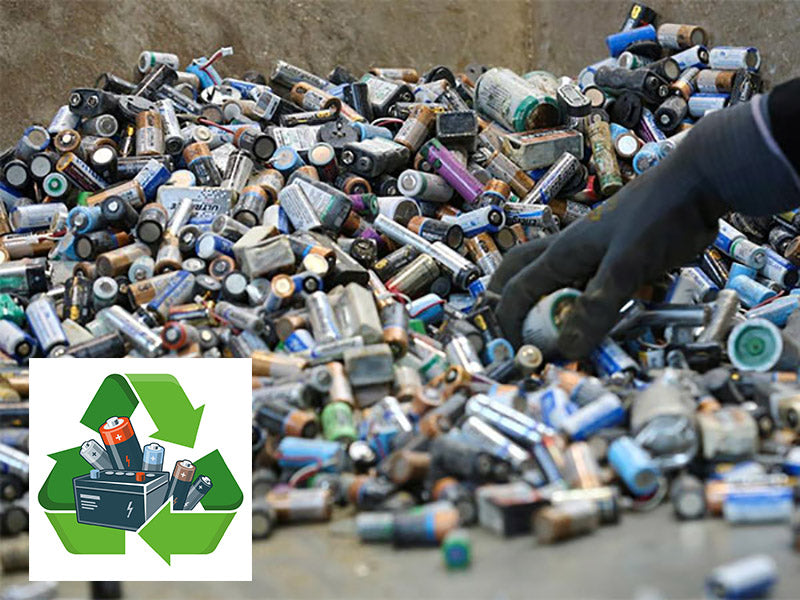
There are two main ways to control waste battery pollution: one is to carry out harmless treatment after collection; the other is to grasp the source and control the use of harmful substances until they are completely replaced, including new harmless batteries to replace harmful batteries and prolong battery life.
Harmless treatment after collection is theoretically the most effective and thorough method, but it is technically difficult to achieve harmless treatment, especially without secondary pollution;
The recycling of some batteries is operated as an industry, which is often difficult to maintain economically and can only be used as a public welfare undertaking. For example, the Japanese government adopts a policy of subsidizing 80 yen per kilogram of waste batteries for the disposal of waste batteries.
Grasping the source, controlling the use of harmful substances, and realizing the reduction or replacement of harmful substances are the common goals pursued by the global battery industry in the past 20 years, and it is also a more effective and economical pollution control method. For example, ordinary zinc-manganese batteries and alkaline zinc-manganese batteries can achieve low mercury and no mercury; replace mercury oxide batteries with zinc-air batteries; replace galvanized cadmium batteries with nickel-hydrogen batteries; extend the life cycle of batteries through improved technology. China's work in this area is basically synchronized with the world. At present, ordinary zinc-manganese batteries and alkaline zinc-manganese batteries have all been required to achieve low mercury, and some companies with good foundations have achieved mercury-free; the new market for small secondary batteries is almost completely occupied by new batteries, the production of nickel-cadmium batteries has gradually decreased, and some traditional markets have also been replaced by nickel-metal hydride batteries; the service life of lead-acid batteries has been extended by means of process improvement, battery maintenance and repair, and intelligent management of battery charge and discharge.
Different countries have adopted different treatment methods for different batteries when controlling the pollution of waste batteries. Most countries require all lead-acid batteries and nickel-cadmium batteries to be recycled, prohibit the production of mercury oxide batteries, and control the amount of mercury used in primary batteries. The management of waste batteries also mainly involves lead-acid, nickel-cadmium, mercury oxide and other types of batteries. For civilian primary batteries such as ordinary zinc-manganese batteries and alkaline zinc-manganese batteries, which are used the most, most countries pay more attention to limiting the mercury content in batteries to achieve mercury-free, and do not implement compulsory recycling. One of the reasons is that the low-mercury and mercury-free batteries have little impact on the environment. The United States used to list such batteries as hazardous waste, but now it has been treated as ordinary solid waste; the second reason is that there is currently no economical and effective treatment method, and recycling and regeneration lack economic feasibility.

From the experience of some countries, the main measure to solve the pollution of the battery industry is to adjust the product structure and eliminate outdated processes and products, which is mandatory by the state. As for the collection, treatment or reuse of waste batteries, they are all carried out voluntarily by industry associations, cities or enterprises. The impact of waste batteries on the environment should be scientifically understood, and its harm should not be exaggerated. Government departments should focus on eliminating mercury-containing batteries. As for classified collection and processing (or utilization), qualified cities and enterprises with technical strength should operate them themselves, and the state should not impose mandatory requirements.
At present, the goals and steps to eliminate mercury-containing batteries have been very clear, and most companies have also done it in accordance with national requirements. However, some companies lag behind the national requirements, and even a few companies use other people's brands to produce high-mercury batteries. These illegal acts can only be stopped by strengthening market supervision.
The mercury content in the battery is low, the consumer groups are scattered, and the waste battery will not cause serious pollution in a certain period of time from the landfill of the domestic waste. However, if a large number of waste batteries are concentrated in one place, coupled with poor handling (such as peeling off the casing, recycling valuable parts, discarding the residue at will, etc.), it may cause mercury pollution in local areas. Therefore, when some units and individuals carry out collection activities, they should properly keep waste batteries and hand them over to units with storage and disposal conditions.
Although it can be considered not to collect dry batteries separately from the perspective of pollution control, some units hope to recover zinc, manganese, iron and other metals in them for the purpose of saving resources. In fact, like other waste comprehensive utilization projects, the scrap metal recycling industry is greatly affected by the fluctuation of raw material market prices and downstream demand. Under the conditions of a market economy, the principle of enterprise voluntariness can be adopted. If the enterprise has the technical and operational capabilities; or from the perspective of public welfare, it can also carry out business in this area. The recycling facilities of mercury-containing batteries should be built in areas with sparse population and insensitive environment, and the technical management level should choose a relatively advanced and large-scale model, and should not be turned into a simple workshop-style processing plant.
Read more: What is the current status of waste battery management?